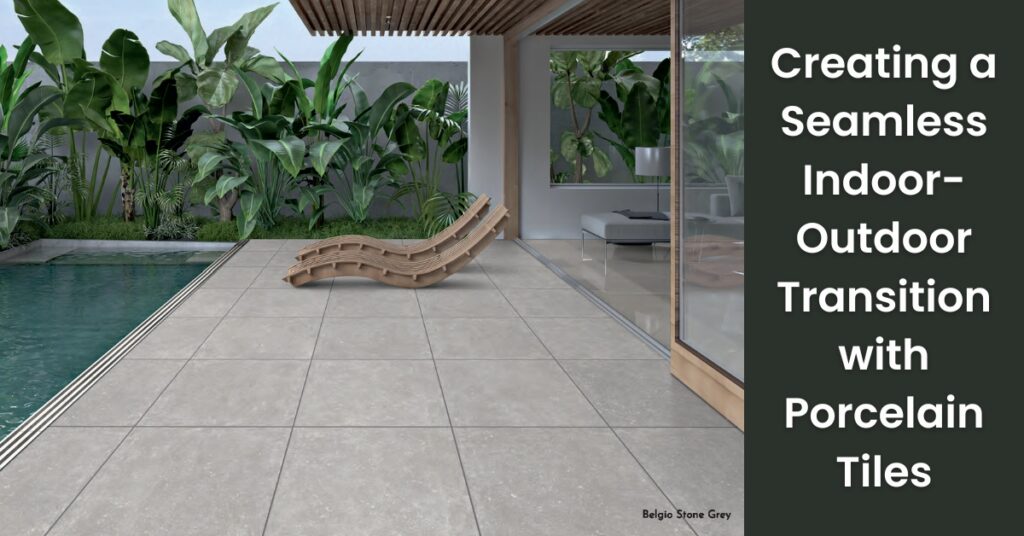When selecting tiles for regions that experience extreme cold, frost-resistant porcelain tiles are the perfect solution. These tiles are designed to withstand freezing temperatures, making them ideal for outdoor spaces, patios, and even unheated areas inside homes. Frost-resistant porcelain tiles combine durability, elegance, and a robust build that can endure the cycles of freezing and thawing without cracking or losing their finish.
In this blog, we’ll explore the qualities of frost-resistant porcelain tiles, offer a comparison table to help you choose the right type, and highlight the best options for colder climates.
Why Choose Frost-Resistant Porcelain Tiles?
Porcelain tiles are known for their durability, but not all tiles are suitable for extreme cold. Frost-resistant porcelain tiles are specially engineered to resist moisture absorption, which prevents them from cracking in freezing conditions. Here’s why they’re an excellent choice for colder regions:
- Low Water Absorption: Frost-resistant tiles have water absorption rates below 0.5%, meaning they won’t crack due to freezing and expansion.
- Strength and Durability: Porcelain tiles are fired at high temperatures, making them extremely hard and resilient. They can withstand heavy loads and resist wear over time.
- Style Variety: From textured and matte finishes to wood-look designs, porcelain tiles come in a wide range of styles, making them versatile for any aesthetic.
- Ease of Maintenance: These tiles are naturally stain- and moisture-resistant, so they require minimal upkeep even in wet or icy conditions.
Key Factors to Consider When Choosing Frost-Resistant Porcelain Tiles
To ensure you’re selecting the best frost-resistant porcelain tiles, keep these factors in mind:
- Absorption Rate: Look for tiles with an absorption rate of 0.5% or less.
- Textured Surface: For outdoor and high-traffic areas, textured or slip-resistant tiles provide additional safety in icy conditions.
- Finish: Matte and natural finishes tend to perform better in cold climates, as they offer greater traction and require less maintenance than polished surfaces.
- Thickness: Thicker tiles generally provide better durability and resistance to frost.
Recommended Frost-Resistant Porcelain Tiles for Cold Climates
Below is a comparison table of some popular types of frost-resistant porcelain tiles, highlighting key characteristics and their suitability for different applications:
| Tile Type | Finish | Water Absorption | Slip Resistance | Best Applications | Key Benefits |
|---|---|---|---|---|---|
| Textured Porcelain Tile | Textured/Matte | < 0.5% | High | Outdoor patios, walkways | Slip-resistant, ideal for icy surfaces |
| Wood-Look Porcelain Tile | Matte | < 0.5% | Medium | Outdoor decks, kitchens | Stylish wood appearance, frost resistance |
| Polished Porcelain Tile | Polished | < 0.5% | Low | Indoor spaces, low-traffic areas | Luxurious look, durable in unheated areas |
| Large Format Porcelain | Matte/Natural | < 0.5% | Medium-High | Outdoor areas, living rooms | Fewer grout lines, modern aesthetics |
| Slip-Resistant Porcelain | Rough/Textured | < 0.5% | Very High | Pool decks, icy pathways | Maximum safety in icy, wet conditions |
| Outdoor Porcelain Pavers | Natural | < 0.5% | High | Patios, balconies, garden paths | Extra-thick, highly durable for outdoors |
Benefits of Using Frost-Resistant Porcelain Tiles
- Enhanced Safety in Cold Weather: Many frost-resistant porcelain tiles come with slip-resistant surfaces, reducing the risk of accidents in icy and wet conditions.
- Reduced Maintenance: Frost-resistant tiles are designed to endure extreme conditions, so they won’t require frequent replacement or repairs.
- Long-Term Durability: These tiles are built to withstand wear and tear, making them ideal for high-traffic areas.
- Wide Range of Styles: From wood-look to large-format tiles, you can achieve any aesthetic without compromising on performance.
Installation Tips for Cold Climates
For optimal performance in cold regions, follow these installation tips:
- Use a Suitable Adhesive: Use a high-quality adhesive designed for outdoor and frost-prone applications to prevent the tiles from shifting or cracking.
- Ensure Proper Drainage: Water pooling on tiles can freeze and cause slipping or damage, so make sure the area has adequate drainage.
- Consider Tile Thickness: Thicker tiles are better suited for outdoor areas, providing additional insulation and durability against frost.
Popular Applications for Frost-Resistant Porcelain Tiles
- Outdoor Patios and Decks: Frost-resistant tiles are perfect for patios and decks in regions with cold winters, providing both beauty and functionality.
- Pool Areas: Slip-resistant porcelain tiles are ideal for pool surrounds, as they prevent accidents while resisting cold damage.
- Walkways and Driveways: Durable enough for high foot traffic, these tiles provide a safe, attractive path in icy and snowy conditions.
Conclusion
Choosing the right frost-resistant porcelain tiles can make all the difference in ensuring a safe, durable, and beautiful surface that withstands freezing temperatures. By focusing on key features like water absorption, slip resistance, and thickness, you’ll find tiles that offer optimal performance for any cold climate.
For more guidance on choosing the best tiles for your specific needs, consult an expert porcelain tile supplier. From textured options to large-format tiles, frost-resistant porcelain tiles provide a durable, stylish, and safe option for cold climates around the world.






